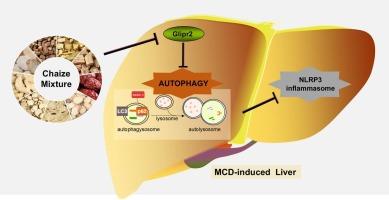Chaize mixture alleviates NAFLD by regulating Glipr2-related autophagy/NLRP3 signaling
IF 4.7
2区 医学
Q2 IMMUNOLOGY
引用次数: 0
Abstract
Chaize Mixture (CZM), formulated by combining Xiaochaihu Decoction and Zexie Decoction, is a time-tested Chinese herbal prescription historically utilized for managing metabolic disorders, including non-alcoholic fatty liver disease (NAFLD). Despite its extensive historical use, the precise mechanisms underlying its therapeutic efficacy remain to be fully elucidated. This study aimed to delineate the molecular mechanisms of CZM in both in vivo and in vitro models of NAFLD. It was found that CZM treatment led to decreased serum ALT (alanine aminotransferase) and AST (aspartate aminotransferase), hepatic TG (triglycerides), and reduced of Srebp1, Fas, Tnf-α, IL-6, IL-1β, Tgf-β, Timp1, Timp2, Acta2, and Adamstl2, while elevating Cpt1a levels. Histopathological assessment revealed that CZM alleviated inflammatory cell infiltration, and fat accumulation in hepatocyte. CZM could increase gut microbial diversity and richness. Further multi-technique comprehensive analysis showed that Glipr2 expression was elevated in the model group but significantly decreased after CZM, which was verified by PCR and Western blotting. In addition, CZM decreased microtubule-associated protein 1 light chain 3B (LC3B), p62, NLRP3, IL-1β, Caspase1 protein levels, and increased the levels of Beclin1.
Conclusion
Our results showed that CZM could ameliorate steatosis, inflammatory response, and fibrosis in NAFLD by promoting autophagy and inhibiting NLRP3-mediated inflammation, which was achieved through regulating Glipr2.

柴泽合剂通过调节glipr2相关的自噬/NLRP3信号通路缓解NAFLD
柴泽合剂(CZM)由小柴胡汤和泽泻汤联合配制而成,是一种久经考验的中草药方剂,历来用于治疗代谢紊乱,包括非酒精性脂肪性肝病(NAFLD)。尽管其广泛的历史使用,其治疗效果的确切机制仍有待充分阐明。本研究旨在探讨CZM在NAFLD体内和体外模型中的分子机制。结果发现,CZM治疗导致血清ALT(丙氨酸转氨酶)和AST(天冬氨酸转氨酶)降低,肝脏TG(甘油三酯)降低,Srebp1、Fas、Tnf-α、IL-6、IL-1β、Tgf-β、Timp1、Timp2、Acta2和Adamstl2水平降低,Cpt1a水平升高。组织病理学评价显示,中药可减轻肝细胞炎症细胞浸润和脂肪堆积。CZM可以增加肠道微生物的多样性和丰富度。进一步多技术综合分析表明,模型组Glipr2表达升高,CZM后明显降低,经PCR和Western blotting验证。此外,CZM降低了微管相关蛋白1轻链3B (LC3B)、p62、NLRP3、IL-1β、Caspase1蛋白水平,升高了Beclin1蛋白水平。结论川芎嗪通过调节Glipr2,促进NAFLD自噬,抑制nlrp3介导的炎症,从而改善NAFLD脂肪变性、炎症反应和纤维化。
本文章由计算机程序翻译,如有差异,请以英文原文为准。
求助全文
约1分钟内获得全文
求助全文
来源期刊
CiteScore
8.40
自引率
3.60%
发文量
935
审稿时长
53 days
期刊介绍:
International Immunopharmacology is the primary vehicle for the publication of original research papers pertinent to the overlapping areas of immunology, pharmacology, cytokine biology, immunotherapy, immunopathology and immunotoxicology. Review articles that encompass these subjects are also welcome.
The subject material appropriate for submission includes:
• Clinical studies employing immunotherapy of any type including the use of: bacterial and chemical agents; thymic hormones, interferon, lymphokines, etc., in transplantation and diseases such as cancer, immunodeficiency, chronic infection and allergic, inflammatory or autoimmune disorders.
• Studies on the mechanisms of action of these agents for specific parameters of immune competence as well as the overall clinical state.
• Pre-clinical animal studies and in vitro studies on mechanisms of action with immunopotentiators, immunomodulators, immunoadjuvants and other pharmacological agents active on cells participating in immune or allergic responses.
• Pharmacological compounds, microbial products and toxicological agents that affect the lymphoid system, and their mechanisms of action.
• Agents that activate genes or modify transcription and translation within the immune response.
• Substances activated, generated, or released through immunologic or related pathways that are pharmacologically active.
• Production, function and regulation of cytokines and their receptors.
• Classical pharmacological studies on the effects of chemokines and bioactive factors released during immunological reactions.

 求助内容:
求助内容: 应助结果提醒方式:
应助结果提醒方式:


